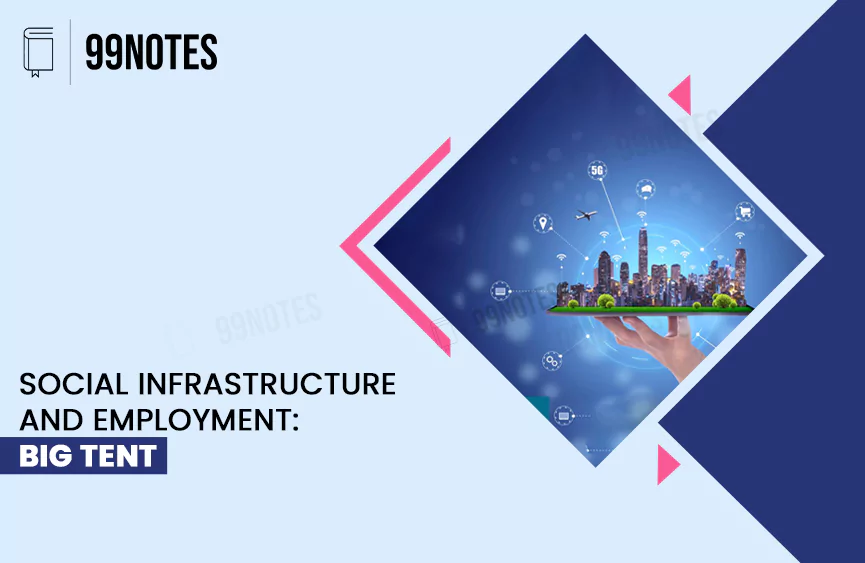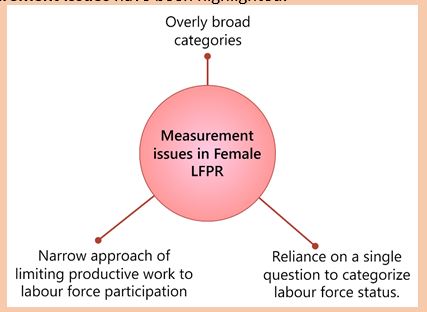Chapter 6: Social Infrastructure and Employment: Big Tent
Social Infrastructure
- Social Infrastructure
- Social Sector Expenditure
- Social sector overall spending
- Education sector spending
- Progress in Human Development Parameters
- Labour Market and Employment
- Trends in School Education (FY22)
- New Schemes in FY23 for school education
- Trends in Higher Education
- Initiatives for Higher Education
- Vocational Education and Skilling
- Health Sector
- Progress in the Health Sector
- Rejuvenation of the Health Sector
- Rural Health Care
- Social Protection
- Rural Development
- Conclusion
- Social infrastructure forms the foundational services and structures that add to the citizens’ quality of life and indirectly contribute to economic development through increased income, better productivity and technological advancement.
- Quality of life encompasses various factors:
- Basic income and employment opportunities
- Education levels;
- Healthcare,
- Social security,
- Connectivity etc.
- Therefore, a robust social infrastructure customized to the country’s diversity and citizens’ unique needs can ensure the quality of life. The government has integrated the broader perspective of the concept of quality of life into its agenda for social infrastructure development. This recognition is echoed in India’s adoption of the UN SDGs 2030.
Social Sector Expenditure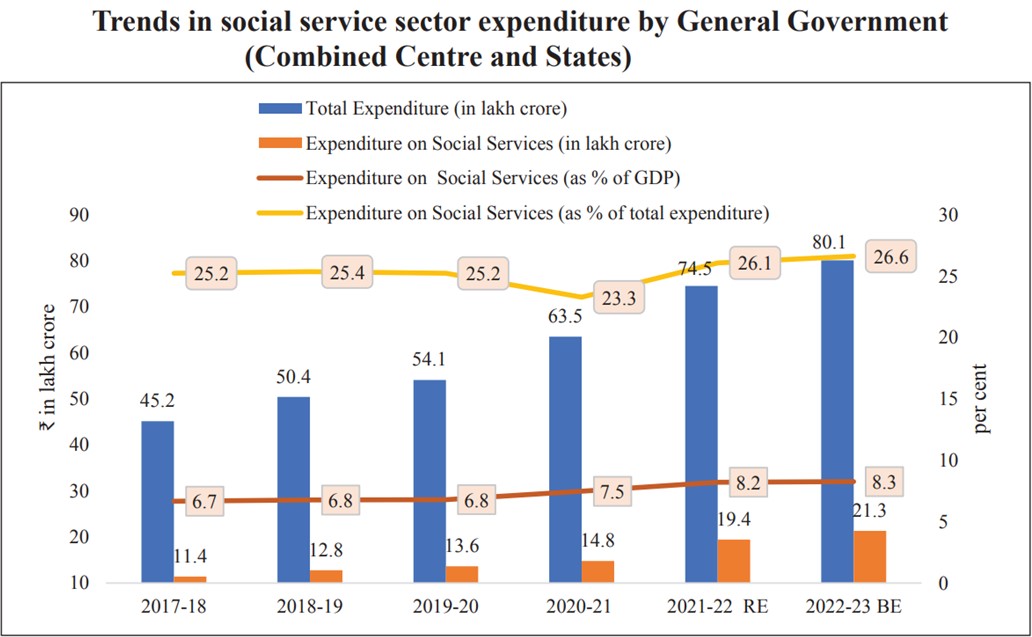
Social sector overall spending
- General Government’s spending in the social sector has been increasing both in absolute terms and as a percentage of the GDP between FY18 and FY23.
- The sharp increase in social sector spending in FY22 over FY21 reflects the urgency created by the pandemic.
Health sector spending in FY23
- Health spending as a share of the total social sector spending has increased from 21% in FY19 to 26% in FY23.
- In FY 2022, the actual spending reached 2.2% of the GDP (RE). In FY23, this number reached 2.1%(BE).
- Comparison with Government Targets:
- The National Health Policy 2017 envisages public health expenditure to reach 5% of the GDP.
- The 15th Finance Commission recommended that the target spending of 2.5% should be achieved by 2025.
Education sector spending
- The expenditure on the education sector as a percentage of the GDP has seen only a marginal change from 2.8% to 2.9% during the last 5 years.
Progress in Human Development Parameters
- HDI Report:
- Globally, there was a reversal in progress achieved in human development due to the Covid pandemic and the Russia-Ukraine war.
- India, too slipped in the 2021 HDI report of UNDP. It ranked 132 out of 191 countries in the 2021 report with a score of 0.633, lower than its value of 0.645 in 2019.
- Gender Inequality Report (GII): India is ranked 122 at a score of 0.490 for 2021.
- Multidimensional Poverty Index (MPI) for India:
- 16.4% of Indians are multidimensionally poor.
- 18.7% are vulnerable to multidimensional poverty.
- The intensity of deprivation is 42%.
- India has an MPI score of 0.069.
- The incidence of multidimensional poverty is 6.1% lower than that of monetary poverty, indicating access to non-income resources to the monetarily poor.
- Around 42 crores were pulled out of poverty from 2005-06 to 2019-21. This trend indicates that India can achieve the SDG target of 1.2 by 2030.
- The poorest states and groups reduced poverty in the fastest absolute terms. There has been a decline in the prevalence of deprivation across all categories (nutrition, child mortality, sanitation, assets etc.).
Aspirational Districts Programme (ADP)
- It was launched in 2018 with a vision of a New India by 2022.
- Aim: To raise the citizens’ living standards and ensure inclusive growth.
- Approach: The districts are pushed and encouraged to compete with one another in the spirit of competitive and cooperative federalism, first catching up to the best district in their state before setting their sights on becoming one of the best in the country.
- Main Pillars:
- Convergence of the Central and the State schemes.
- Collaboration of stakeholders (Central, State level Nodal Officers & District Collectors).
- Competition among districts through monthly delta rankings.
- Jan Andolan (Mass movement).
- With States serving as the primary drivers, this programme focuses on each district’s strengths, identifying areas that can be improved right away and tracking progress by ranking districts each month.
- Aspirational District Ranking ranking tracks 49 indicators across 5 broad socio-economic themes, namely,
- Health and nutrition,
- Education,
- Agriculture and water resources,
- Financial inclusion and skill development,
- Basic infrastructure.
- 117 most-backwards districts have been identified as aspirational districts (AD) based on these indicators.
- NITI Aayog has prepared a broad template for formulating the district plans. Moreover, the Central government ministries have created a primer of steps needed to improve each of the indicators related to their ministries. The states can customize these templates and guidelines states to match the opportunities and challenges specific to a district.
- Achievements of ADP
- Many ADs have surpassed state averages in several indicators.
- There have been significant improvements in critical indicators related to Maternal and Infant Mortality Rates and schools complying with the Right to Education.
- Several ADs have outperformed the non-ADs in the outcome of financial indicators.
- Several ADs have reported saturation of the basic infrastructure indicators related to electricity connections, all-weather road connectivity and households with toilets.
- ADP as a template for good governance
- The ADP has emerged as a template for good governance, especially in remote and less accessible areas.
- ‘Mission Utkarsh’ and Aspirational Block Programme (ABP) have been modelled on ADP.
- Mission Utkarsh
- Launched in 2022.
- 15 Central ministries having an interface with the public have identified low 10-15 performing districts. The ministries have launched initiatives to bring these districts at par in the first year and close to the all-India average in the second year.
- ABP is a replication of the ADP model at the block level. 500 aspirational blocks have been identified.
Aadhar led Tech-Driven Social Sector
- Advantages of Aadhar:
- Adhar Secures the social contract between the citizen and the State: It simplifies the citizen-government link as it is an all-purpose single ID for an individual, taking the place of a complex system of multiple IDs for multiple purposes.
- Basis of Digital Economy: It is the vehicle upon which the robust Indian digital economy is riding, giving India a competitive advantage. Referring to Aadhar Paul Romer, a Nobel laureate and former World Bank Chief Economist, said it is “the most sophisticated ID programme in the world.”
- Essential tool for social delivery by the State: It underpins the targeted delivery of financial services, subsidies and benefits under various schemes by enabling an improved beneficiary identification. Under the Aadhar Act 2016, 318 Central Schemes and over 720 DBT schemes have been notified.

| Aadhar Use | Description |
| DBT | • When linked to a bank account, an Addhar serves as the ‘financial address’ of a citizen.
• Through the Aadhar Payment Bridge (APB), there is no need for any other financial information, like bank account number, IFSC code, etc., to make any payment. |
| Aadhaar Enabled Payment Systems (AEPS) | • AEPS enables banking-at-doorstep by enabling basic banking services like cash withdrawal, cash deposit, fund transfer from one’s bank account, etc., just by using their Aadhar. |
| JAM (Jan-Dhan, Aadhaar, and Mobile) trinity | • JAM system has enabled the seamless transfer of benefits of schemes, transparent and accountable governance and brought marginalized sections of people into the formal financial system.
Ex: MNREGS payments. |
| One Nation One Ration Card (ONORC) Scheme | • Seeding the PDS database with Aadhar enables seamless portability of ration cards across States. In addition, this enables deduplication and removal of ghost beneficiaries.
• PM Garib Kalyan Yojana using Aadhar-seeded PDS, has been instrumental in fighting the nutritional needs of the poor during Covid. |
| PM Kisan Samman Nidhi, PMKSS | • For PMKSS, the Aadhar platform has enabled registration through Aadhar eKYC and DBT through APB. |
| Co-WIN | • Aadhar data has been at the base of the government’s successful vaccination programme against Covid-19. |
| Face Authentication | • Face authentication with linkage to Aadhar is an emerging modality for authentication. This has been the case with ‘Jeevan Praman’, where the elderly authenticate themselves using a smartphone to get their pension. |
Labour Market and Employment
Labour reforms undertaken.
- Labour codes
- 29 Central Labour Laws were amalgamated, rationalized, and simplified as 4 Labour Codes:
- Code the Code on Wages, 2019,
- Industrial Relations Code, 2020,
- Code on Social Security, 2020, and
- Occupational Safety, Health & Working Conditions Code, 2020.
- These labour codes align with the changing labour market trends, minimum wage standards, welfare needs of the entire spectrum of workers, present economic scenario, technological advancements, and the requirements of the ease of doing business.
- These reforms aim to ease compliance, catalyze the creation of employment opportunities, and ensure the workers’ safety, health, and social security.
- Using technology, such as web-based inspection, ensures transparency and accountability in enforcement.
- The codes also decriminalize minor offences.
- 29 Central Labour Laws were amalgamated, rationalized, and simplified as 4 Labour Codes:
- E-Shram Portal
- Launched by the Ministry of Labour and Employment, it is an Aadhar-verified national database of unorganized workers, including migrant workers, construction workers, gig, and platform workers etc.
- Aim: To improve the life and dignity of the country’s labour force by safeguarding the interests of the workers, ensuring their welfare, and providing social security for the workers in the unorganized and organized sectors.
- The database captures essential details about the workers, such as name, occupation, occupation type, address, educational qualifications, skillset etc., to ensure the optimum realization of their employability and provide them with welfare benefits.
- The portal has been linked to the NCS and ASEEM portals to ensure seamless services to the workers.
- Data:
- Female registration has exceeded the male registrations on the portal.
- Most registrations belonged to 18-40 years old.
- Uttar Pradesh, West Bengal, and Bihar accounted for more than half of the registrations.
Employment Trends
There are two routes to studying employment trends:
- Supply-side of the labour
- Demand-side of the labour
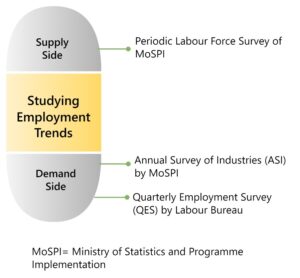
| Quarterly Employment Survey (QES) | • Conducted by the Labour Bureau.
• Covers establishments with 10 or more workers in 9 major sectors, viz. manufacturing, construction, trade, transport, education, health, accommodation & restaurants, IT/BPOs, and financial services. • These 9 sectors account for over 83% (as per the 6th Economic Census 2013-14) of the total employment in establishments with 10 or more workers. |
| Annual Survey of Industries (ASI) | • Conducted by MoSPI.
• It is an important source of industrial statistics of the registered organized manufacturing sector of the economy. • Covers all factories registered under Sections 2m(i) and 2m(ii) of the Factories Act, 1948, i.e., those factories employing 10 or more workers using power; and those employing 20 or more workers without using power. |
- The employment trends have already been discussed in the introduction sector. Some of the other trends are as below.
- Employment categories:

- Based on the industry of work:
| Sector | Share of workers in the sector for the year | FY20 | FY21 | Comments |
| Agriculture | 45.6% | 46.5% | Marginal increase |
| Manufacturing | 11.2% | 10.2% | Faint decline |
| Construction | 11.6% | 12.1% | Increase |
| Trade, hotel and restaurants | 13.2% | 12.2% | Decrease |
The above trends can be attributed to the impact of Covid on the manufacturing and services sector, while agriculture sector growth remained strong.
- Trends reflected in the QES (Q4 FY22):
- Sectorwise share of total employment:

- Types of workers in the 9 sectors:
- Regular workers form the majority across the sectors.
- Contractual employees formed a relatively small portion of the workforce except in the cases of construction and manufacturing.
- Only a little less than 2% are self-employed.
- Sectorwise share of total employment:
- Trends from ASI 2019-20 for the organized manufacturing sector:
- Formalization: Employment size data shows an increasing formalization of the economy.
- There has been a gradual increase in employment per factory.
- There are a larger number of companies with low employment sizes and a few with higher employment sizes.
- The increase in the number of bigger factories employing more than 100 workers is such that their share is increasing in the total number of factories.
- This trend is also reflected in the data of the Employees’ Provident Fund Organization (EPFO) and the Employees’ State Insurance Organization (ESIC). The increased formal sector payroll addition can be attributed to the Aatmanirbhar Bharat Rojgar Yojana as a boost to the economy during Covid-19 through new job creation while ensuring social security.
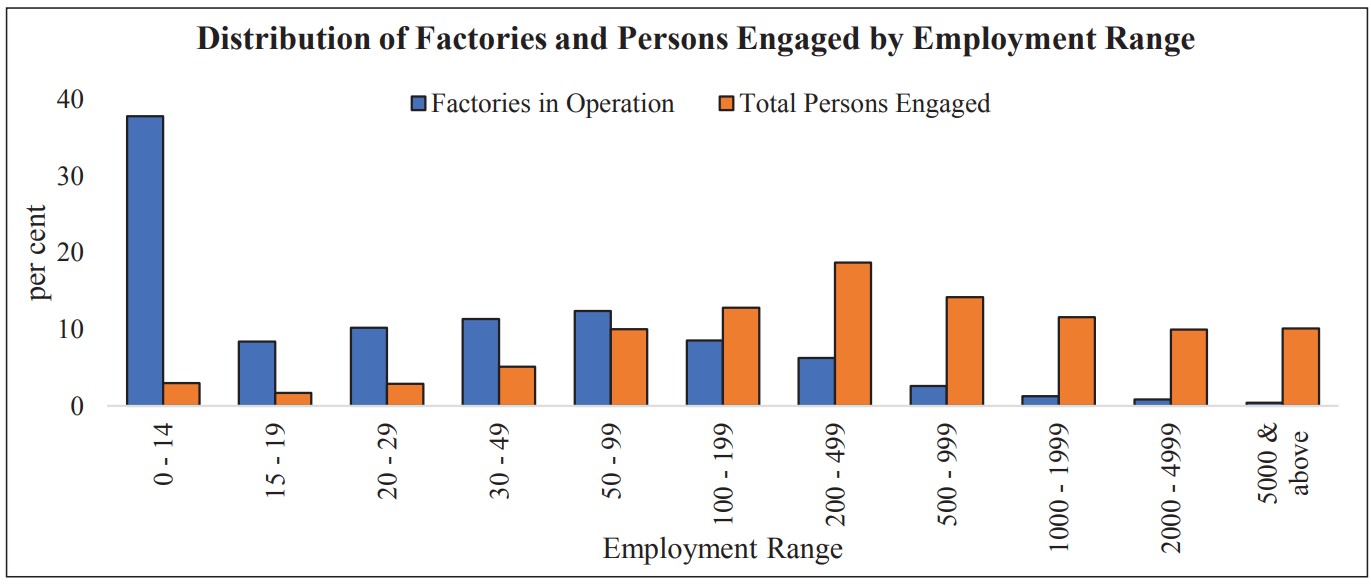
- Scaling-up:
- The increase in persons employed by larger factories is faster than that in smaller factories, indicating the scaling-up of manufacturing units.

- The increase in persons employed by larger factories is faster than that in smaller factories, indicating the scaling-up of manufacturing units.
- Share of employment by sector: food products industry > wearing apparel > basic metals.
- States’ share in employment: Tamil Nadu > Gujarat > Maharashtra > Uttar Pradesh > Karnataka > Haryana.
- Formalization: Employment size data shows an increasing formalization of the economy.
- Rural wages have also increased for males and females, which might translate into real wages as inflation subsides.
- Changes in female labour force participation rate (Female LFPR):
- As a result of rising rural amenities freeing up women’s time and high agricultural growth over the years, the female LFPR shows a rise between FY18 and FY21.
- All states, except Manipur and Meghalaya, have contributed to the rise in female LFPR.
Meaurement Issues in female LFPR
| Measurement Issues in female LFPR |
| ⦿ The survey content and design used for measuring the female LFPR can yield significantly different numbers.
⦿ Three measurement issues have been highlighted:
1) Using overly broad categories clubbing productive work (collecting firewood, poultry, farming, etc.) with domestic duties can put a significant share of women in the out-of-labour-force category. Thus, current numbers on female LFPR are significantly underestimated. 2) Reliance on a single question for measuring the labour participation status eliminates the scope for rectifying any error in self-reporting. Therefore, ILO recommends adding multiple probing or ‘recovery question’ (additional questions) to help double-check the individual’s responses to the primary question. 3) Measurement of “Work” alongside “Employment”: Broadening the horizon of measuring work to include all productive activities along with employment can lead to improved quantification of work. With this change, the measure of work would cover market products as well as all the productive work, including those in the domestic domain. In particular, women’s unpaid domestic work, such as cooking, firewood collection, tutoring children, etc., can be counted as expenditure-saving work. Correcting these measurement issues can nullify the gender-based disadvantages in the labour mark. Moreover, these corrections facilitate the women’s free choice to join the labour market. An appropriate support system in the form of affordable crèches, career counselling and handholding, lodging, transportation, etc., can help unlock the gender dividend for inclusive and broad-based growth. |
Role of Self-Help Groups (SHG) in Women’s empowerment
Role of Self-Help Groups (SHG) in Women’s empowerment |
| ⦿ India has 1.2 crore SHGs, 88% of which are all-women SHGs. Some of the successful women SHGs are: ✓ Kudumbashree in Kerala, ✓ Jeevika in Bihar, ✓ Mahila Arthik Vikas Mahila Mandal in Maharashtra, and ✓ Looms of Ladakh.
⦿ Women’s economic SHGs have resulted in a positive and significant effect on women’s economic, social, and political empowerment. This positive effect has been achieved through various pathways, such as familiarity with handling money, financial decision-making, improved social networks, asset ownership and livelihood diversification. ⦿ Role in microfinance: The SHG Bank Linkage Project (SHG-BLP) of 1992 has emerged as the world’s largest microfinance project catering to the small and marginalized sections. Achievements of SHG-BLP: o Covers 14.2 crore families through 119 lakh SHGs. o The number of credit through the SHG-BLP has grown at a CAGR of 10.8% during the last 10 years. o Credit disbursement per SHG has increased at a CAGR of 5.7% in the previous 10 years. o Notably, SHGs’ bank repayment is over 96%, highlighting their credit discipline and reliability. ⦿ Role in DAY-National Rural Livelihood Mission (DAY-NRLM): The SHG-driven DAY-NRLM has brought several benefits to the functionaries as well as the participants. These include women empowerment, self-esteem enhancement, personality development, reduced social evils, better education, higher participation in village institutions and better access to government schemes.
⦿ SHG and the Covid-Response: The women SHGs have evolved as a platform to unite women across their group identities and work collectively for crisis management. During the Covid pandemic, women SHGs played a crucial role in the following forms:
⦿ Way Forward: The SHGs are well-placed for bringing in rural development due to the following: 1. Their access to the last mile 2. Their ability to draw on communities’ trust and solidarity 3. Their knowledge of local dynamics 4. They can swiftly manufacture simple products and services by aggregating members’ economic activities. The demonstration of their resilience and flexibility during crises, including Covid, needs to be thus regularised for long-run rural transformation. The following measures are required to make SHGs a potent force for this purpose: 1. Addressing the inter-regional disparity in the deepening of the SHG movement. 2. Graduating SHG members into micro-entrepreneurs. 3. Culturally contextualized skill development for moving up the value chain in products and services. 4. Including the least privileged under the SHG umbrella. 5. Since over 75% of the rural female workers are engaged in agricultural activities, SHGs have a prominent role to play. The SHGs can upskill and create employment in agricultural-related sectors for rural women. |
National Career Service Project
- Launched in 2015, it is a one-stop solution providing an array of employment and career-related services.
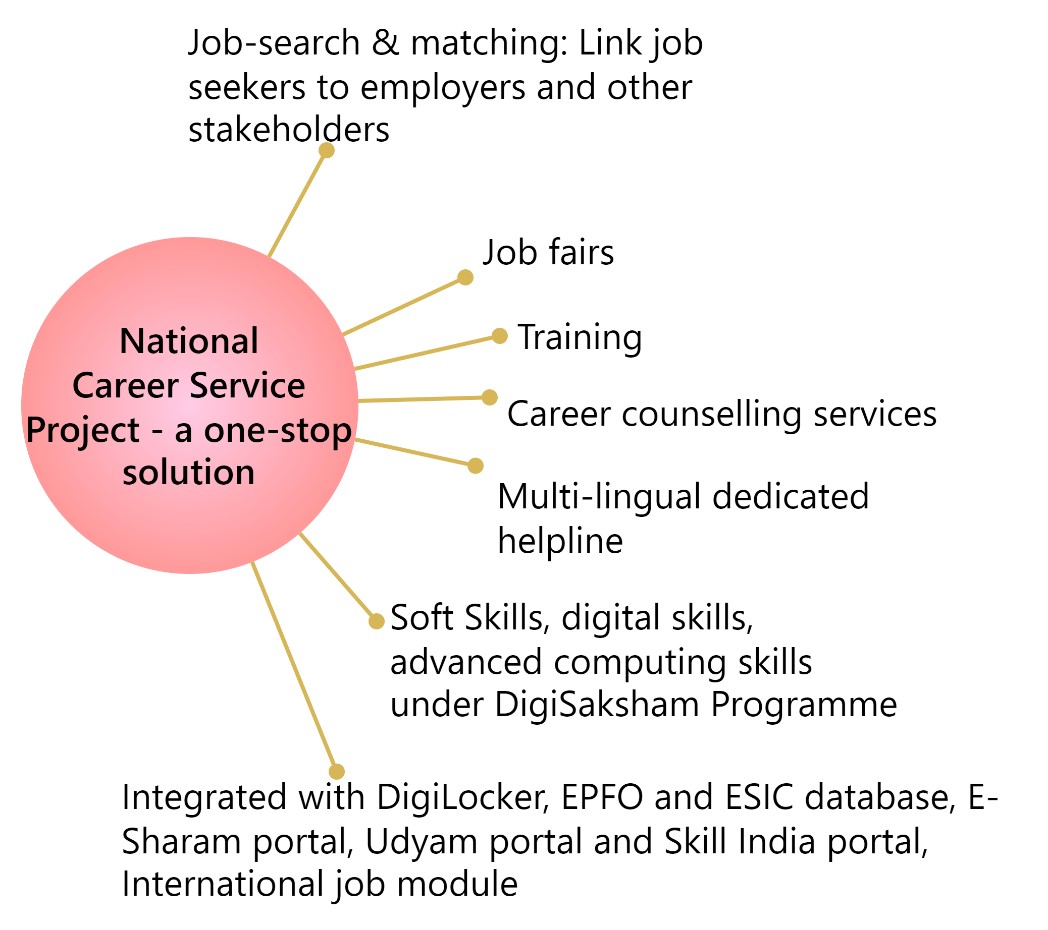
Education Sector
The NEP 2020 was formulated to create a new system aligned with the aspirational goals of 21st century-education, including the UN SDG4 while building upon India’s traditions and value systems. It recognizes education as the lifeblood of human capital formation for a young country like India.
The NEP provides for nurturing all-around development and skill acquisition by youth in an inclusive, accessible, and multilingual set-up.
Trends in School Education (FY22)
| Gross Enrolment Ratio | ⦿ Improved for both the boys and the girls in the primary as well as the upper primary levels age groups.
o In both the primary and upper primary cases, the girls’ GER was better than the boys’. ⦿ Declined for the secondary level age group. ⦿ There was a 3% increase in total enrolment of Children With Special Needs (CWSN). |
| School drop-out | ⦿ It saw a steady decline at all levels. |
| School infrastructure | ⦿ Basic facilities such as toilets (girls or boys), drinking water, and hand-washing facilities have improved and are available in most government schools. |
| Teacher availability | ⦿ The pupil-teacher ratio has improved at all levels continuously from FY13 to FY22. |
New Schemes in FY23 for school education
- PM Schools for Rising India (PM SHRI)
- Around 14,500 schools will be designated as PM SHRI schools. They will be provided with modern infrastructure (labs, smart classrooms, sports equipment, art room, etc.), showcase the implementation of the NEP and emerge as exemplary schools while offering leadership to other schools in the neighbourhood.
- They shall also be developed as green schools with water conservation, waste recycling, energy-efficient infrastructure, and integration of organic lifestyle in the curriculum.
- National Curriculum Framework (NCF) for foundational Stage
- NCF for Foundational Stage has been launched as the new 5+3+3+4 curricular structure, which integrates early childhood care and education for all children aged 3 to 8.
- NCF uses ‘play’ at the core of the conceptual, operational, and transactional approaches to curriculum organization, pedagogy, time and content organization, and the child’s overall experience.
- Pilot Project of Balvatika
-
- Project Balvatika of “Preparatory Class” was launched in 49 Kendriya Vidyalaya. The programme focuses on developing cognitive, affective, and psychomotor abilities, and early literacy and numeracy for students aged 3+, 4+ and 5+ years.
- Toy-based Pedagogy
-
- It aims to integrate indigenous toys and their pedagogy into the curriculum of school education, early childhood care and education and teacher education.
- PRASHAST, a Disability Screening mobile app
- It will be used to screen disability conditions at the school level and generate the school-wise report. In addition, the authorities shall use this data for initiating the certification
- National Credit Framework (NCrF)
-
- Within the NEP, the NCrF is an umbrella framework for skilling, re-skilling, up-skilling, accreditation, and evaluation. NCrF will seamlessly integrate the credits earned from school to higher education levels and from vocational and skill education.
- The move will open numerous options for further progression of students and mainstream vocational and skill education at school and higher education levels.
- Strengthening Teaching-Learning and Results for States (STARS)
-
- It is a World Bank-funded programme aimed at improving the quality and governance of school education in the selected states.
- Vidyanjali Scheme (A School Volunteer Scheme)
-
- It facilitates volunteers, corporates, and communities to contribute their knowledge, skills and assets or material or equipment to the government or government-aided schools.
- The various supports offered to these schools are: subject assistance, mentoring gifted children, imparting vocational skills, providing ceiling fans and water purifiers, gifting digital devices for learning via virtual mode, musical instruments, self-defence training to schoolgirls, assistance for basic civil infrastructure and other classroom needs, etc.
- Shiksha Samagra Scheme
-
- It is an overarching programme for the school education sector extending from preschool to class 12. It has been aligned with the NEP 2020.
- The scheme’s ICT component lays a special focus on computer literacy, computer-aided education, digital books, virtual labs, smart classrooms etc.
Trends in Higher Education
| Parameter | Change FY21 vs FY20 |
| Total enrolment | • Increased by 5.1%.
• 21% increase since FY15. |
| Female enrolment | • Increased by 5.2% |
| Enrolment in Distance Education | • 7% increase.
• 20% increase since FY15. |
Initiatives for Higher Education
- R&D Cell (RDC) in Higher Education Institutions (HEI)
-
- Launched by University Grants Commission (UGC).
- Aim = To establish an RDC in HEIs with the mandate for promoting quality research that contributes meaningfully towards the goal of a self-reliant India, aligned with the provisions of NEP 2020.
- The RDC would help create a research ecosystem for reliable, impactful, and sustained research output.
- The programme will facilitate the collaboration of stakeholders, including the industry and agencies from local to international levels, and ensure greater access to research through fund and resource mobilization.
- Guidelines for Simultaneously Pursuing two Academic Programmes have been issued by the UGC in line with the vision of NEP 2020, viz. providing flexible curricular structures to enable creative combinations of disciplines for study that would offer multiple entry and exit points, thus, removing currently prevalent rigid boundaries and create new possibilities for life-long learning through critical and interdisciplinary thinking.
- Interest Subsidy on Education Loans taken by students from economically weaker sections (EWS) having parental income less than ₹4.5 lakh/yr. for professional study in India.
Vocational Education and Skilling
Skill development aims to bridge the gap between the current supply and demand for a skilled workforce. It also seeks to address the gap that may occur by making the workforce future-job ready.
Steps taken by the government
- Ministry of Skill Development and Entrepreneurship (MSDE) was created, and Skill India Mission was launched in 2015. Later National Skill Development Corporation was established, and the National Policy on Skill Development and Entrepreneurship was launched.
- Initiatives under Skill India Mission:
- Pradhan Mantri Kaushal Vikash Yojana (PMKVY)
- Jan Shikshan Sansthan Scheme
- National Apprenticeship Promotion Scheme
- Craftsmen Training Scheme
- Craft Instructor Training Scheme
- Skill acquisition and Knowledge Awareness for Livelihood Promotion (SANKALP)
- Deen Dayal Upadhyaya Grameen Kaushalya Yojana (DDUGKY),
- Rural Self Employment Training Institutes (RSETI),
- Deen Dayal Antyodaya Yojana-National Urban Livelihood Mission (DAY-NULM)
- Skill India International (SII) Network.
To make India a Skill Capital of the World and improve the mobility of the skilled workforce, the National Skill Development Corporation (NSDC) International has been set up to create a network of institutions across India. This institution network will be called Skill India International (SII) Network. It shall be created through the empanelment of state-of-the-art government and private institutions.
- NEP 2020 also lays down a particular focus on vocational education and skill development. It emphasizes integrating vocational education with general education and mainstreaming vocational education.
Trends in Skilling
- There is an improvement in formal vocational/technical training among youth (age 15-29 years) and the working population (age 15-59 years) for FY21, in both rural and urban sectors and both for males and females.
- In the organized sector, the number of firms providing formal skill training and on-the-job training is quite significant (in the range of 15-21%).
Health Sector
Initiatives for the health sector
Guided by the overarching goals of ‘universal health coverage’ and ‘quality and affordable health for all’, multidimensional initiatives have been launched.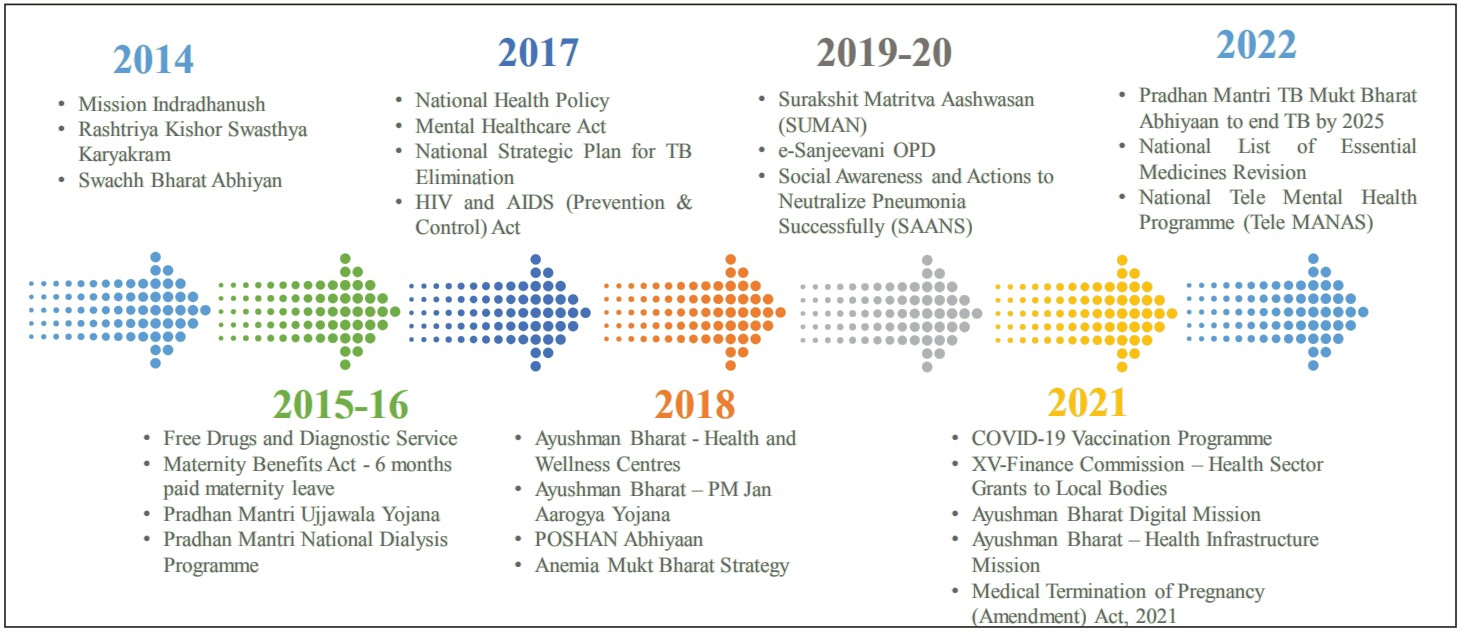
Initiatives in FY23:
- Intensified Mission Indradhanush 4.0 was conducted in 416 districts to cover children and pregnant women who missed routine immunization during the Covid-19 pandemic.
- eSanjeevani – National Telemedicine Service of India
-
- It is an innovative, indigenous, cost-effective, and integrated cloud-based telemedicine system application to enable patient-to-doctor teleconsultation to ensure a continuum of care and facilitate health services to all citizens in the confines of their homes, free of cost.
Progress in the Health Sector
There has been considerable progress in health indicators between NHFS-4 (2015-16) to NHFS-5 (2019-21), as shown below:
| NFHS-4 (2015-16) | NFHS-5 (2019-21) | |
| Households with any usual member covered under a health insurance/ financing scheme (%) | 28.7 | ⬆️41.0 |
| Total fertility rate (children per woman) | 2.2 | ⬇️ 2.0 |
| Current Use of Family Planning Method- Any Method (%) | 53.5 | ⬆️66.7 |
| Mothers who had at least 4 antenatal care visits (%) | 51.2 | ⬆️58.1 |
| Institutional births (%) | 78.9 | ⬆️88.6 |
| Neonatal mortality rate/NMR (per 1000 live births) | 29.5 | ⬇️24.9 |
| Infant Mortality Rate/IMR (per 1000 live births) | 40.7 | ⬇️35.2 |
| Under-5 mortality rate/U5MR (per 1000 live births) | 49.7 | ⬇️41.9 |
| Children aged 12-23 months fully vaccinated based on information from either vaccination card or mother’s recall (%) | 62.0 | ⬆️76.4 |
| Children under age 6 months exclusively breastfed (%) | 54.9 | ⬆️63.7 |
| Children under 5 years who are stunted (height-for-age) (%) | 38.4 | ⬇️35.5 |
| Children under 5 years who are wasted (weight-for-height) (%) | 21.0 | ⬇️19.3 |
| Children under 5 years who are underweight (weight-for-age) (%) | 35.8 | ⬇️32.1 |
| Children under 5 years who are overweight (weight-for-height) (%) | 2.1 | ⬆️3.4 |
| Women who are overweight or obese (BMI≥25.0 kg/m2) (%) | 20.6 | ⬆️24.0 |
| Men who are overweight or obese (BMI≥25.0 kg/m2) (%) | 18.9 | ⬆️22.9 |
| Women aged 15-24 years who use hygienic methods of protection during their menstrual period (%) | 57.6 | ⬆️77.3 |
- India has achieved the major milestone of bringing the MMR to below 100 per lakh live births by 2020.
- There has been a steady downward trend in IMR, U5MR, NMR and early-NMR in the last decade.
- The doctor-population ratio in the country is 1:834 against WHO norms of 1:1000.
- Health Sector Spending:
- Government health expenditure (GHE) as a share of GDP is 1.3% in FY19.
- Total health expenditure (THE) is about 2% of the GDP (FY19).
- GHE as a share of THE is around 41% in FY19. States’ share in GHE is approximately 66%.
- Primary healthcare expenditure of government as a share of GHE (FY19): about 55%.
- Primary and secondary care government expenditure share in GHE (FY19): around 86%.
- Social security expenditure on health of government on health (FY19): 6%.
- This expenditure includes those on social health insurance programmes, government-financed health insurance schemes and medical reimbursements made to government employees.
- The out-of-pocket expenditure as a share of THE has declined substantially from 64.2% in FY14 to 48.2% in FY19.
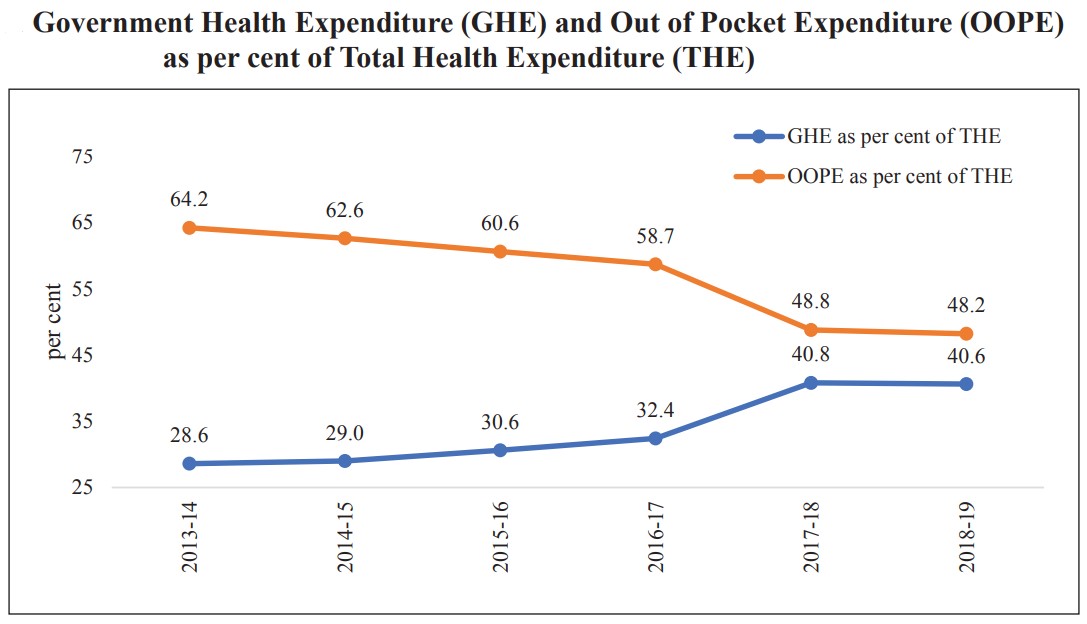
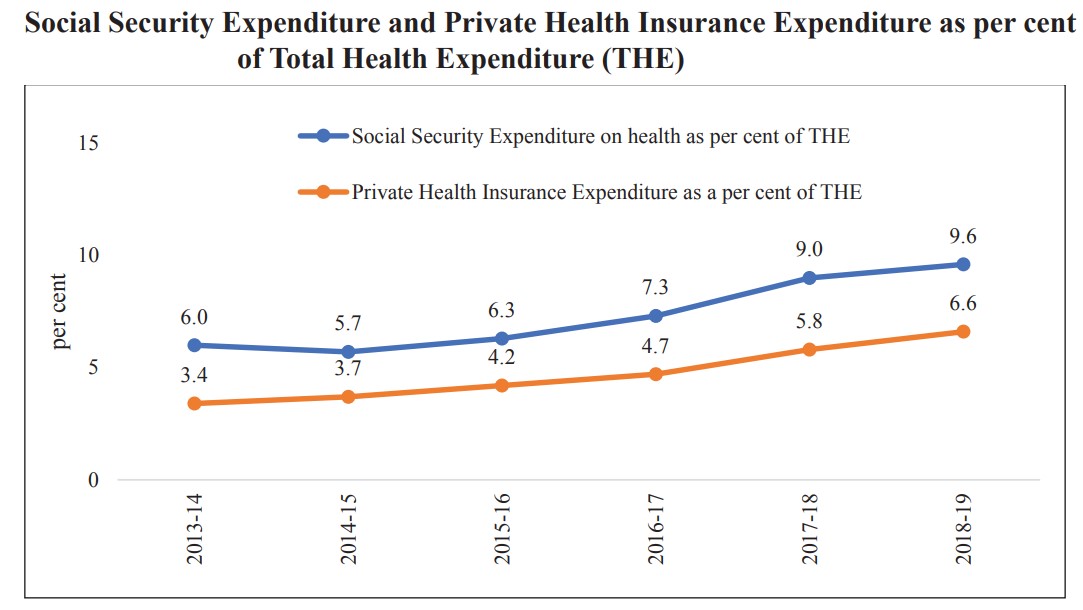
Rejuvenation of the Health Sector
The health infrastructure came under huge stress due to the unprecedented situation presented by the Covid-19 pandemic. The central and the state government’s response to the challenge was also unprecedented that had the effect of rejuvenating the health sector. The measures taken are:
- Use of an agile approach based on feedback loops, real-time monitoring of actual outcomes, flexible responses, and safety-net buffers.
- Ramping up health infrastructure, both physical and digital
- Enhanced training of health professionals
- Scaling up expenditure on health infrastructure by
- Investing in grass root health institutions and ramping up HWCs in rural and urban areas;ss
- Setting up critical care hospital blocks in all districts; and
- Strengthening the laboratory network and surveillance by integrated public health laboratories in all districts and blocks and public health units to manage pandemics.
- Bolstering digital infrastructure through Co-WIN for mass vaccination and e-Sanjeevani for telemedicine to reach the last mile.
Rural Health Care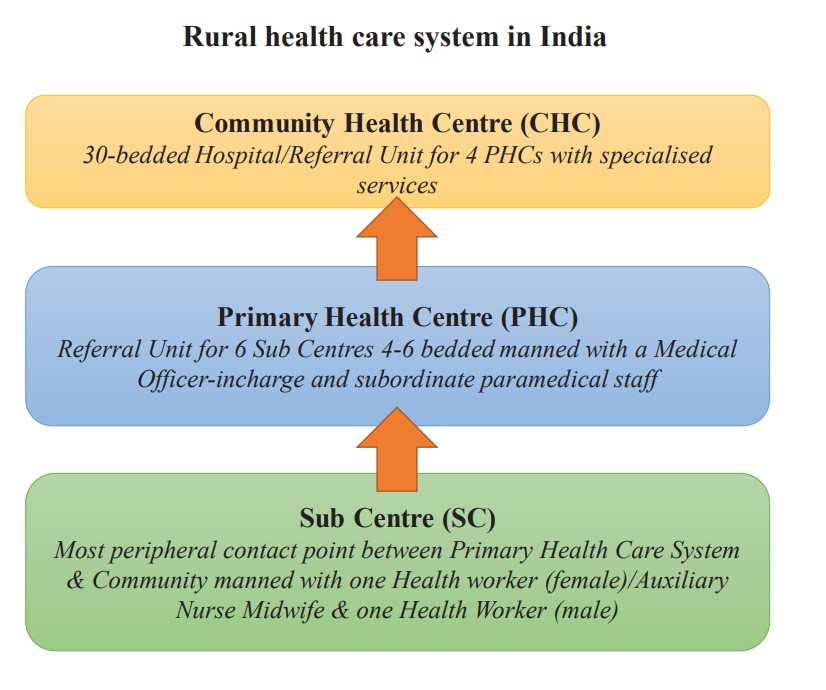
To secure last-mile delivery of public health services, the government has made concerted efforts to strengthen the public health infrastructure and the health sector human resources, emphasizing rural health care.
- This effort has translated into an increased number of Sub-centres (SCs), Primary Health Centres (PHCs), and Community Health Centres (CHCs) in rural areas, along with the rise in doctors, nurses, and other medical personnel over time.
- With the implementation of the Ayushman Bharat programme, the strengthening of SCs and PHCs are being done by converting them into Health and Wellness Centres (HWCs) in a phased manner to deliver comprehensive Primary Healthcare services through these Centres.
| National Deworming Day (NDD): Grabbing the Low-Hanging Fruits in Child Health |
| • NDD was launched in 2015
• It is a fixed-day approach to treating intestinal worm infections in children aged 1-19 years with Albendazole tablets. • The programme covers both school and out-of-school children. • Soil-Transmitted Helminthiases (STH), called parasitic intestinal worm infection, affects children in many ways, as shown below: • With the deworming initiative, improvements can be seen in: o school absenteeism o health, nutritional, and learning outcomes o higher wages in jobs o It also supplements the Swachh Bharat Abhiyan in eliminating sanitation-related health risks. • Compared to the low cost of the intervention, the combined benefits of deworming lead to a remarkably high benefit-to-cost ratio. • Thus, National Deworming Day is a low-hanging fruit of programme innovations in health well plucked for deep-rooted development. |
Social Protection
Social protection is needed for people who remain vulnerable to crises, such as health issues, natural disasters, old age, job loss, etc. Initiatives of the government for social protection:
- Pradhan Mantri Vaya Vandana Yojana (PMVVY)
- Pradhan Mantri Jeevan Jyoti Bima Yojana (PMJJBY)
- Pradhan Mantri Suraksha Bima Yojana (PMSBY)
- Pradhan Mantri Shram Yogi Maan-dhan Yojana (PM-SYMDY)
- PM Street Vendor’s Atmanirbhar Nidhi Scheme (PM SVANidhi)
- PM Mudra Yojana
Rural Development
The development of rural areas has become imperative for the government, given that most of the Indian population lives in rural areas (65% in 2021), and large numbers depend on agriculture for livelihood (47%). Therefore, the government is emphasizing improving the quality of life in rural areas to ensure more equitable and inclusive development.
Approaches to ensure the quality of life in rural areas cover areas like:
- Income
- Skill development
- Rural connectivity
- Education and Healthcare
- Sanitation and Drinking Water and Clean Cooking Fuel
- Rural Housing and Electricity
- Social Security
- Rural governance
- Tech-enabled service delivery and digitization.

Enhancing rural income
- MGNREGS: Some initiatives under the MGNREGS include the geotagging of assets, mandatory expenditure on agriculture and allied activities, e-Payments using the National Electronic Fund Management System (Ne-FMS), and DBT. Other recent initiatives are:
-
- Project “UNNATI” ➜ to upgrade the skill base of the MGNREGS workers.
- Area Officer Monitoring App ➜ to facilitate the authorities to record their findings online
- National Mobile Monitoring Software (NMMS) App ➜ for real-time attendance of MGNREGA workers at work sites.
- Standard Operating Procedures (SoP) for visits were developed to improve the quality of the social audit process for all the states/UTs.
- Deendayal Antyodaya Yojana-National Rural Livelihood Mission (DAY-NRLM)
- It aims to enable economically vulnerable households to access gainful self-employment and skilled wage employment opportunities resulting in sustainable and diversified livelihood options.
- It is a ‘community-driven’ approach which provides a massive platform in the form of community institutions for women’s empowerment.
- SHG members trained as Community Resource Persons (CRPs) help implement the Mission at the ground level.
- Components:
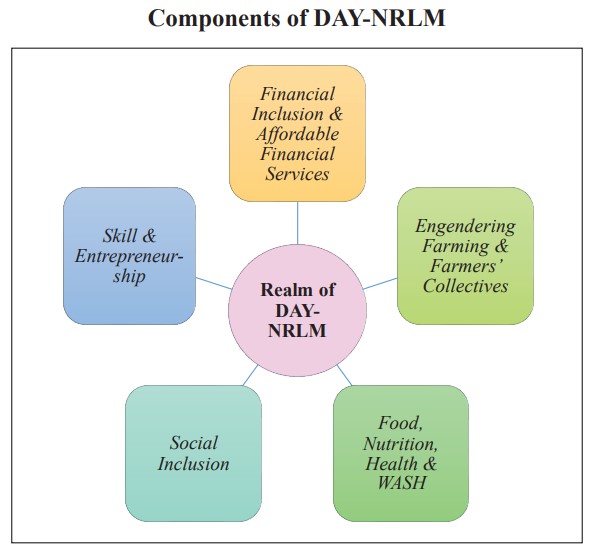
- Deen Dayal Upadhyaya Grameen Kaushalya Yojana (DDU-GKY)
-
- It is a placement-linked skill development programme for the poor rural youth under NRLM.
Rural Housing
- Pradhan Mantri Awas Yojana –Gramin (PMAY-G)
Drinking Water and Sanitation
- Jal Jeevan Mission à For availability of safe and potable drinking water at the doorstep of every rural household ad public institution in the village.
- Swachh Bharat Mission (Grameen)
- Mission Amrit Sarovar (2022)
- Objective: To conserve water for the future.
- Aim: To develop and rejuvenate 75 water bodies in each district of the country during the Amrit Varsh (2022), the 75th Year of Independence.
- Jaldoot app ➜ to measure the water level in a Gram Panchayat through 2-3 selected open wells twice a year (pre-monsoon and post-monsoon).
- Pradhan Mantri Ujjwala Yojana 2.0, Swachh Indhan Behtar Jeevan
Rural connectivity
- Pradhan Mantri Gram Sadak Yojana (PMGSY) ➜ To provide all-weather road connectivity to rural areas and thus enable the basic services to reach the rural areas. It has positively impacted agriculture, health, education, urbanization and employment generation.
Rural Electricity
- SAUBHAGYA– Pradhan Mantri Sahaj Bijli Har Ghar Yojana
- Deendayal Upadhyaya Gram Jyoti Yojana (DDUGJY)
Rural governance for inclusive growth
- Rashtriya Gram Swaraj Abhiyan (RGSA)
-
- RGSA primarily focuses on capacity building and training (CB&T) to empower PRIs and prepare convergent plans at the individual panchayat level with the overall objective of strengthening PRIs.
- RGSA was revamped in 2022. It now re-imagines PRIs as vibrant centres of local self-governance with a particular focus on the Localisation of SDGs (LSDGs) at the grassroots level adopting a thematic approach through concerted and collaborative efforts of Central Ministries and State line departments and other stakeholders with ‘Whole of Government and Whole of Society’ approach.
- The revamped scheme aims to strengthen institutions’ capacities for rural local governance to become more responsive towards local development needs, prepare participatory plans leveraging technology, and efficiently utilize available resources for realizing sustainable solutions to local problems linked to SDGs adopting the 9 thematic approaches of LSDGs.
- Svamitva Scheme à for digitization of land records in rural areas for creating accurate land records. Benefits include:
- Comprehensive village-level planning (Gram Panchayat Development Plans) enabled by GIS maps
- Reducing property-related disputes.
- Making productive use of land.
- Monetizing land as a financial asset for raising loans and other financial benefits.
- Levying property tax on the land can become another source of revenue for the village or the state exchequer.
Direct Benefit Transfer (DBT)
- DBT via JAM Number Trinity has become a targeted and less distortive means of distributing subsidies for the benefit of the poor and vulnerable.
- DBT played a key role in sustaining life, especially for the underprivileged segments of society, helping millions by providing immediate relief. In addition, cash transfers under central schemes and scholarship schemes of various ministries were a significant relief for all the adversely affected masses of India during the Covid-19 period.
- To make DBT schemes more accessible and transparent, end-to-end digitization of major DBT schemes has been done. Unified Mobile Application for New Age Governance (UMANG) mobile app serves as a one-stop access for these schemes. In addition, Common Service Centres (CSCs) across the country cater to the population who do not have mobile phones.
- In the years of its operation, the DBT paradigm has enabled the following:
- Accurate identification and targeting of beneficiaries.
- Greater inclusion and ease of availing services through online application.
- Transparency in fund transfers to beneficiaries.
- Curbing of leakages in the benefit delivery processes through the elimination of intermediaries/agents.
- Creation of greater accountability on behalf of the government.
- Facilitating reforms in government processes through re-engineering.
- Increase in efficiency in scheme delivery processes; and
- Effectiveness of schemes through timely implementation.
Conclusion
- Integrating human development with technology leads to an all-encompassing revolutionary innovation that can spur growth and prosperity driven by technology.
- In a nation as large and diverse as India, implementing broad-based inclusive social policies for equitable development is fraught with difficulties, which the government is addressing by enacting mindful reforms.
- The infusion of technology with the involvement of grassroots governance has ensured the successful implementation of schemes measured in terms of the benefits reaching the intended beneficiaries.
- Moreover, technology has enabled good governance by fostering transparency and accountability in scheme implementation.
- Thus, the potential role of technology in achieving the lofty goals under UN-SDG cannot be overstated.
- Some policy recommendations for ensuring more equitable economic growth can include:
- Stepping up learning outcomes through digital and teaching interventions in schools,
- Enhancing the role of community workers in healthcare,
- Pushing SHGs through better product design and upscaling enterprises.
- Channelizing women’s economic potential through ecosystem services, such as affordable market alternatives for care work, safe transportation and lodging, and long-term counselling support, can help capitalize on the gender dividend for the country’s future economic and social development.

